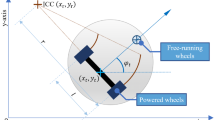Abstract
Recently, many extensive studies have been conducted on robot control via self-positioning estimation techniques. In the simultaneous localization and mapping (SLAM) method, which is one approach to self-positioning estimation, robots generally use both autonomous position information from internal sensors and observed information on external landmarks. SLAM can yield higher accuracy positioning estimations depending on the number of landmarks; however, this technique involves a degree of uncertainty and has a high computational cost, because it utilizes image processing to detect and recognize landmarks. To overcome this problem, we propose a state-of-the-art method called a generalized measuring-worm (GMW) algorithm for map creation and position estimation, which uses multiple cooperating robots that serve as moving landmarks for each other. This approach allows problems of uncertainty and computational cost to be overcome, because a robot must find only a simple two-dimensional marker rather than feature-point landmarks. In the GMW method, the robots are given a two-dimensional marker of known shape and size and use a front-positioned camera to determine the marker distance and direction. The robots use this information to estimate each other’s positions and to calibrate their movement. To evaluate the proposed method experimentally, we fabricated two real robots and observed their behavior in an indoor environment. The experimental results revealed that the distance measurement and control error could be reduced to less than 3 %.












Similar content being viewed by others
Notes
In this paper, we define a performance of less position estimation error by comparison of GPS as high-accuracy.
References
Negishi Y, Miura J, Shirai Y (2003) Map generation of a mobile robot by integrating omnidirectional stereo and laser range finder. J Robot Soci Japan 21(6):690–696 (in Japanese)
Kurazume R, Motomura A, Yamaguchi Y, Matsuoka T, Yamamoto M, Hasegawa T (2004) Robust positioning method using omni-directional camera and dead reckoning for soccer robots. J Robot Soc Japan 22(3):343–352 (in Japanese)
Miura J, Morita H, Hild M, Shirai Y (2007) A view-based outdoor localization using object and location recognition based on support vector learning. J Robot Soc Japan 25(5):792–798 (in Japanese)
Kawai K, Nakazawa A, Kiyokawa K, Takemura H (2005) Development of a control system of a mobile robot for 3D reconstruction of a disaster area. Inst Electr Inf Commun Tech Rep IEICE 105(256):13–18 (in Japanese)
Hattori K, Homma E, Otani M, Ichikawa Y, Matsushima H, Sato K, Harada T, Takadama K (2012) Automatic cartography method by cooperation of autonomous micro robots and its verification through simulations. In: International conference on humanized system 2012 (ICHS 2012), pp 228–231
Matsumoto Y, Inaba M, Inoue H (2002) View-based approach to robot navigation. J Robot Soc Japan 20(5):506–514 (in Japanese)
White HD, Bailey T (2006) Simultaneous localization and mapping: part I. IEEE Robot Autom Mag 13:99–108
Morimoto Y, Namekawa T (2009) Simultaneous localization and mapping problem using extended Kalman filter. Japan Soc Mech Eng Motion Vibration Control 11:200–205 (in Japanese)
Bailey T, Nieto J, Guivant J, Stevens M, Nebot E (2006) Consistency of the EKF-SLAM algorithm. In: Proceedings of the 2006 IEEE/RSJ, international conference on intelligent robots and systems, pp 3562–3568
Castellanos JA, Martinez-Cantin R, Tards JD (2007) Robocentric map joining: improving the consistency of EKF-SLAM. Robot Auton Syst 55:21–29
Bailey T, Nieto J, Nebot E (2006) Consistency of the FastSLAM algorithm. In: Proceedings of the 2006 IEEE international conference on robotics and automation, pp 424–429
Montemerlo M, Thrun S, Koller D, Wegbreit B (2002) FastSLAM: a factored solution to the simultaneous localization and mapping problem. In: Proceedings of the AAAI, national conference on artifical intelligence, Edmonton, Canada, 2002
Gutierrez A, Campo A, Santos FC, Monasterio-Huelin F, Dorigo M (2009) Social odometry: imitation based odometry in collective robotics. Int Adv Robot Syst (ARS) 6(2):129–136
Fraga D, Gutierrez A, Vallejo JC, Campo A, Bankovic Z (2011) Improving social odometry robot networks with distributed reputation systems for collaborative purposes. Article Sensors 11(12):11373–11389
Gutierrez A, Monasterio-Huelin F, Campo A, Magdalena L (2011) Self-organized distributed localization based on social odometry. In: Chugo D, Yokota S (eds) Introduction to modern robotics I, Chapter 1. iConcept Press, New York, pp. 1–24
Kurazume R, Tobata Y, Murakami K, Hasegawa T (2007) Study on CPS-SLAM -3D laser measurement system for large scale architectures. J Robot Soc Japan 25(8):1234–1242 (in Japanese)
Yougjin J, Iwashita Y, Kurazume R (2012) Study on CPS-SLAM -Improvement of measurement precision and application for tunnel shape measurement system. J Robot Soc Japan 30(2):180–187 (in Japanese)
Kato H, Billinghurst M (1999) Marker tracking and HMD calibration for a video-based augmented reality conferencing system. In: Proceedings of the 2nd international workshop on augmented reality (IWAR)
Homma E, Kagawa T, Hattori K, Otani M, Nakata M, Ichikawa Y, Harada T, Matsushima H, Sato K, Takadama K, Nakajima N (2013) Estimation of cooperation navigation by multiple rovers using different positioning technique. In: International symposium on space technology and science (ISTS), 2013
ZigBee. http://www.zigbee.org/
Xbee Pro. http://www.digi-intl.co.jp/ (in Japanese)
Arduino Mega. https://www.arduino.cc/en/Main/arduinoBoardMega2560
Acknowledgments
This work was supported by JSPS KAKENHI, Grant Number: 25870232.
Author information
Authors and Affiliations
Corresponding author
Additional information
This work was presented in part at the 1st International Symposium on Swarm Behavior and Bio-Inspired Robotics, Kyoto, Japan, October 28–30, 2015.
About this article
Cite this article
Hattori, K., Homma, E., Kagawa, T. et al. Generalized measuring-worm algorithm: high-accuracy mapping and movement via cooperating swarm robots. Artif Life Robotics 21, 451–459 (2016). https://doi.org/10.1007/s10015-016-0301-x
Received:
Accepted:
Published:
Issue Date:
DOI: https://doi.org/10.1007/s10015-016-0301-x




